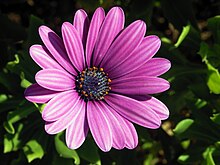Osteospermum
| Osteospermum | |
|---|---|
 |
|
| Purple Osteospermum flower | |
| Scientific classification | |
| Kingdom: | Plantae |
| (unranked): | Angiosperms |
| (unranked): | Eudicots |
| (unranked): | Asterids |
| Order: | Asterales |
| Family: | Asteraceae |
| Subfamily: | Asteroideae |
| Tribe: | Calenduleae |
| Genus: |
Osteospermum L. |
| Species | |
|
See text |
|
See text
Osteospermum /ˌɒstiəˈspɜːrməm, -tioʊ-/, the daisybushes is a genus of flowering plants belonging to the Calenduleae, one of the smaller tribes of the sunflower/daisy family Asteraceae.
Osteospermum used to belong to the genus Dimorphotheca, but only the annual species remain in that genus; the perennials belong to Osteospermum. The genus Osteospermum is also closely related to the small genus Chrysanthemoides, such as C. incana and C. monilifera.
The scientific name is derived from the Greek osteon (bone) and Latin spermum (seed). It has been given several common names: African daisy, South African daisy, Cape daisy and blue-eyed daisy.
There are about 50 species, native to Africa, 35 species in southern Africa, and the southwestern Arabian Peninsula. They are half-hardy perennials or subshrubs.
Their alternate (rarely opposite) leaves are green, but some variegated forms exist. The leaf form is lanceolate. The leaf margin is entire, but hardy types are toothed.
The daisy-like composite flower consists of disc florets and ray florets, growing singly at the end of branches or sometimes in inflorescences of terminal corymbose cymes. The disc florets are pseudo-bisexual and come in several colors such as blue, yellow and purple. The hardy types usually show a dark blue center in the disc until the yellow pollen is shed. The ray florets are female and are found diverse colors such as white, cream, pink, purple, mauve to yellow. Some cultivars have "spooned" petals such as "Pink Whirls". Many species flower a second time late summer, stimulated by the cooler night temperatures. Hardy types show profuse flowering in the spring, but they do not get a second flush of flowers.
...
Wikipedia
